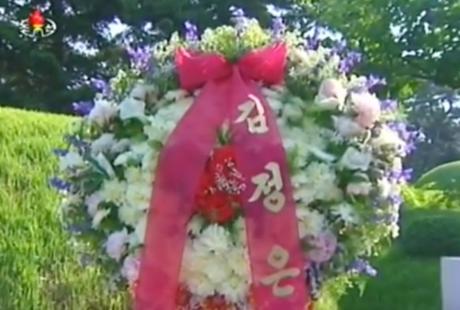
Floral wreath from Kim Jong Un in front of Kim Hyong Jik’s grave in Mangyo’ngdae, Pyongyang, on June 5, 2016 (Photo: Korean Central TV).
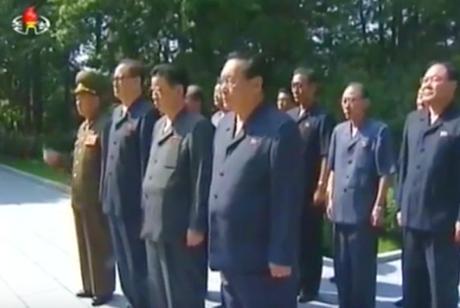
Senior DPRK officials pay their respects at Kim Hyon Jik’s grave on June 5, 2016. In the front row (left to right) are: 1st Vice Minister of the People’s Armed Forces and WPK Political Bureau Alternate Member Colonel-General No Kwang Chol, WPK Vice Chairman for International Affairs and WPK Political Bureau Member Ri Su Yong, DPRK Vice Premier and WPK Political Bureau Member Ro Tu Chol and Korean Social Democratic Central Committee Chairman Kim Yong Dae (Photo: Korean Central TV).
The 90th anniversary of the death of Kim Hyong Jik, father of DPRK President and founder Kim Il Sung, was marked on June 5 (Sunday), along with the 50th anniversary of the Ponghwa-ri Revolutionary Site in Kangdong County, Pyongyang.
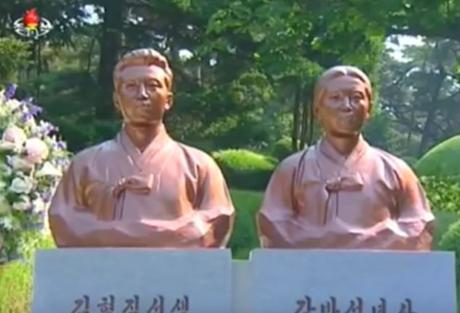
Grave of Kim Hyong Jik and Kang Pan Sok (Photo: Korean Central TV).
Floral wreaths were placed before a statue of Kim Hyong Jik at the Ponghwa-ri Revolutionary site, in Sakju County, North P’yo’ngan, and Chunggang County, Jagang, and before KHJ’s grave in Mangyo’ngdae. Attending the wreath-laying ceremonies were Ri Su Yong (Vice Chairman of the Workers’ Party of Korea [WPK] for International Affairs, Member of the WPK Political Bureau and Member of the WPK Executive Policy Council), Kwak Pom Gi (WPK Vice Chairman for Planning and Finance, Member of the WPK Political Bureau and Member of the Executive Policy Council, Ro Tu Chol (DPRK Vice Premier, State Planning Commission Chairman and Member of the WPK Political Bureau), Colonel-General No Kwang Chol (1st Vice Minister of the People’s Armed Forces and Alternate [candidate] Member of the WPK Political Bureau), Kim Yong Dae (Chairman of the Korean Social Democratic Party Central Committee), senior WPK and Korean People’s Army [KPA] cadres, officials and functionaries of workers’ and social organizations, DPRK Government ministries, agencies and institutions and various DPRK citizens and schoolchildren. Floral wreaths from Kim Jong Un (Kim Cho’ng-u’n), the WPK Central Committee, security organizations and units, the DPRK Government, various schools and training institutions and agricultural and commercial organizations were delivered to the KHJ statues.
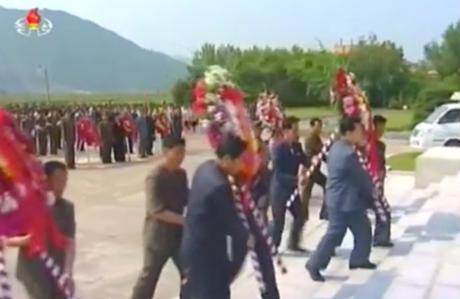
Floral wreaths are delivered to the foot of a Kim Hyong Jik statue in Chunggang County, Chagang Province on June 5, 2016 (Photo: Korean Central TV).
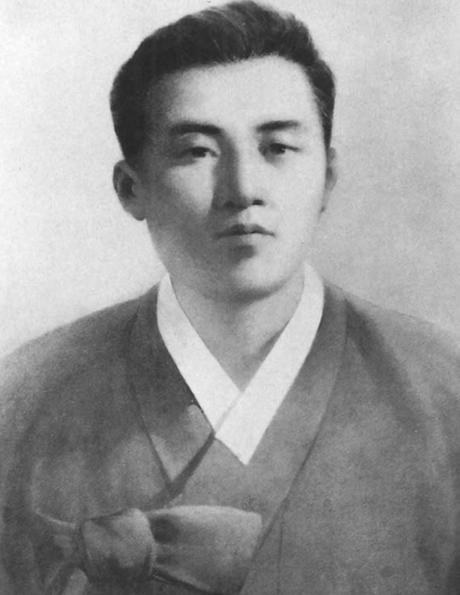
Kim Hyong Jik (1894-1926), father of late DPRK President and founder Kim Il Sung (Photo: NK Leadership Watch file photo).
Linked to commemorations of Kim Hyong Jik’s death anniversary and was marking the 50th anniversary of the establishment of the Ponghwa-ri Revolutionary Site in Kangdong County. Kim Hyong Jik was a school teacher at Ponghwa-ri and Kim Il Sung supposedly resided there when he was five years old. According to the official folklore of the WPK Party History Institute, and Kim Il Sung’s own memoir With the Century, Kim Hyong Jik also led anti-Japanese revolutionary activities from Ponghwa-ri culminating in the purported founding of the Korean National Association. According to With the Century:
By that time our family had moved from Mangyo’ngdae to Ponghwa-ri, Kangdong. There he taught at Myo’ngsin School during the daytime and enlightened the masses at night school, as he had done in Mangyongdae. He used to return home very late.
In a literary exercise at school I made a speech against the Japanese, from a composition prepared for me by my father.
In those days he composed revolutionary poems and songs and enthusiastically taught them to his pupils.
Many independence fighters visited my father at Ponghwa-ri. He himself traveled frequently around North and South P’yo’ngan Provinces and Hwanghae Province to visit his comrades. In the course of this, hardcore elements were trained and a mass foundation for the independence movement was laid.
[. . .]
From the day following my father’s arrest the Christians living in Ponghwa-ri gathered at Myo’ngsin School early every morning and prayed for his release.
People from Pyongyang, Kangdong and the surrounding area swarmed to the Pyongyang Police Station with petitions for his release.
On hearing that my father was soon to be put on trial, my grandfather in Mangyo’ngdae sent my uncle to the police station. He wanted to know whether my father wished to have a lawyer to defend him at the trial or not. When my uncle said that he would find the money to hire a lawyer by selling some household goods, my father flatly refused.
“A lawyer speaks with his mouth, and I can do the same. So there is no need to waste money on a lawyer. An innocent man does not need a lawyer to defend him!”
The Japanese imperialists tried my father three times at the Pyongyang local court. Each time my father protested against the trial, saying, “How can it be a crime for a Korean to love his country and work for it? I cannot recognize this unwarranted examination by the authorities.”
As a result, the trial dragged on. At the third trial the Japanese imperialists sentenced him to a term in prison.
After my father’s imprisonment uncle Hyong Rok and my second uncle on my mother’s side (Kang Yong Sok) came to Ponghwa-ri to take us to Mangyongdae.
But my mother said that she would remain at Ponghwa-ri through the winter. She wanted to remain there in order to get in touch with the members of the Korean National Association and other anti-Japanese fighters who might visit there, and to resolve any problems caused by my father’s arrest.
After dealing with all such problems my mother took us to Mangyo’ngdae in the spring of the following year. My two grandfathers came to Ponghwa-ri with a cart to carry away our household goods.
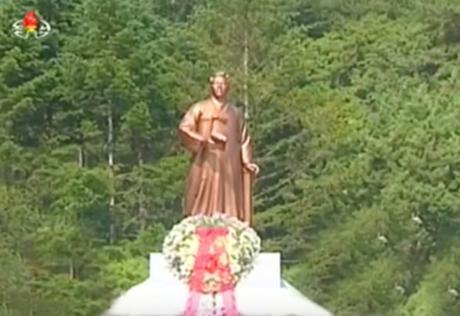
Kim Jong Un floral wreath in front of the Kim Hyong Jik statue in Chunggang County, Chagang Province. (Photo: Korean Central TV).
A meeting to mark the 50th anniversary of the Ponghwa-ri Revolutionary Site was held on June 5. According to KCNA, Kim Il Sung visited Ponghwa-ri on April 10, 1966, recalled the lives of Kim Hyong Jik and his wife Kang Pan Sok and “ascertained historical materials one after another” then went on to give “field guidance to it more than 10 times to teach the principled issues arising in the preservation of the revolutionary relics.” Kim Jong Il “made sure that the revolutionary museum was built into the base of studying the revolutionary activities of Kim Hyong Jik and the base of educating the masses and personally named it…he also went to the spot several times and solved problems arising in the work of preserving and managing the historical site.” During the anniversary meeting a message from the WPK Central Committee to the Ponghwa-ri Revolutionary Site’s employees and managers was read, and other speeches were made.
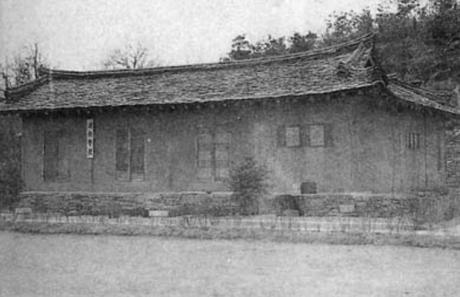
The school where Kim Hyong Jik taught in Ponghwa-ri (Photo: NK Leadership Watch file photo)
The Ponghwa-ri Revolutionary Site was established at a time when the factualization process around Kim Il Sung, the Kim Family and Kim Jong Suk was intensified in order to establish a culture of veneration around the Kim Family. Part of this included establishing Kim Il Sung as the predominant anti-Japanese hero in North Korean political culture and tying his activities to a machinated family history of anti-imperialist actions by his ancestors and anti-Japanese activities by Kim Hyong Jik, his father. Also ascribed to KHJ is the slogan “Aim High” which KCNA and Rodong Sinmun noted during the weekend. According to KCNA, “‘aim high’ is an idea for calling for liberating the country by fighting through generations.” Of Kim Hyong Jik, it said “with this idea he groped for a way to liberate the country and formed the Korean National Association, an anti-Japanese underground revolutionary organization…he demonstrated the inevitability of the proletarian revolution and advanced a policy of shifting the anti-Japanese national liberation movement from nationalist movement to proletarian revolution.”
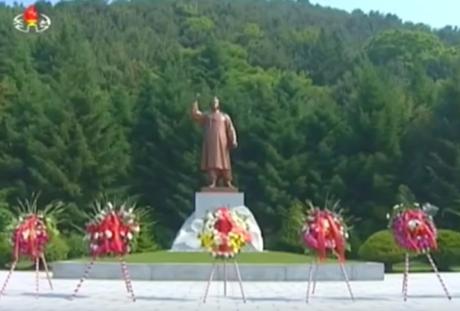
Statue of Kim Hyong Jik in Sakju County, North P’yo’ngan on June 5, 2016 (Photo: Korean Central TV).
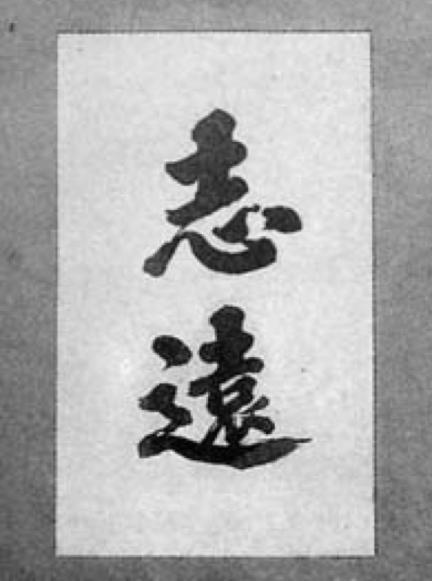
Jiwon slogan at Ponghwa-ri (Photo: NK Leadership Watch file photo)
According to Kim Jong Il’s official biography, at a young age KJI received an inkstone from his grandparents and wrote out the slogan. Later, in 1952, KJI recited the poem “Green Pine on Nam Hill,” a poem ascribed to Kim Hyong Jik which includes “aim high” (and is the Green Pine of the Green Pine Associated Corporation) for Kim Il Sung. According to KJI’s multi-volume biography:
Kim Il Sung explained to the boy how that had been his grandfather’s life-long creed; how his grandfather had fought all his life against the Japanese imperialists to win the independence of the country, determined to achieve his aim at any cost—determined, if he failed, that his son would do it, and if his son failed, then grandson; how his grandfather, when dying, had left to his son two pistols which symbolized the motto “Aim High”, pistols with which he had organized the first armed force, declared war against the Japanese and liberated the country; and that the Korean revolution, however, was still incomplete, for the revolution would continue until Korea was reunified as an independent country and until all imperialists were swept off the face of the earth.
This passage contains a very subtle change. Until 2002 it read “determined to achieve his aim at any cost, determine if he failed that his son would do it” In 2003, the passage was revised to include “grandson” (“determined to achieve his aim at any cost, determined if he failed that his son would do it, and if his son failed, then grandson”) after an October 2002 Rodong Sinmun editorial included the subtle revision. This was the apotheosis of a hereditary succession in support of one of the sons of KJI’s fourth wife (consort) Ko Yong Hui, and now refers to Kim Jong Un.
Filed under: Central Committee, Central Military Committee, central party life, Col. Gen. No Kwang Chol (KPAGS), DPRK Cabinet, DPRK External Relations, Education Section (PAD), Executive Policy Bureau, Gen. Yun Jong Rin, Guard Command, ideological slogans, Ideological Works, International Affairs Department WPK, International Department, Jagang KWP Provincial Committee, Jagang Provincial People's Committee, Kim Family, kim jong suk, Kim Jong-il, Kim Jong-un, Kim Yong Dae, KJI/KJU Ideological Works, Ko Yong Hui, Korean People's Army (KPA), Korean Social Democratic Party, Korean Workers' Party (KWP), Local Party Affairs, local people's committees, Ministry of the People's Armed Forces (MPAF), North Korean press, North Pyongan KWP Provincial Committee, North Pyongan Provincial People's Committee, Organization and Guidance Department, PAD Guidance Section, Party History Institute, Political Bureau, Provincial Party Committees, Provincial Party System, Public Events, Publications, Ri Chol, Ri Su Yong, Ro Tu Chol, Workers' and Social Organizations
